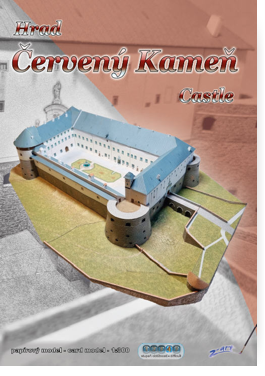

ABOUT ČERVENÝ KAMEŇ CASTLE
Červeny Kameň Castle (The Red Stone Castle) is located in Slovakia, in the Pezinok district, about two kilometers far from Častá village. It was built as a fortress to protect the Czech-Slovak borders, and also to protect a trade route. The foundation of the fortress is associated with the daughter of the Hungarian king Béla III and the Czech queen (the second wife of the Czech king Přemysl Otakar I), Constance of Hungary. Constance´s activities are also connected with the surrounding places – she had a part in building nearby cities Hodonín (on the Czech side) and Trnava (on the Slovak side), as well as in founding of a nunnery in Tišnov. The castle, known as Červený Kameň (Rothenstein in German, Vöröskö in Hungarian, sometimes also referred to as Beaver Castle – Bibersburg), was built before 1240. The fortress was a part of the defense line of the border castles, stretching from Bratislava to Žilina.
Initially, it was a royal castle, and then in 1296 it was bought by one of the most famous Hungarian noblemen, Matúš Čák Trenčianský. After he died, the castle briefly returned to the king. Afterwards, it often changed its owners, among which were the lords of Svätý Jur and Pezinok, Zapoljski family, Thurzo family. The Thurzo family was connected with one of the richest European families of that time, the financiers of the Augsburg Fuggers, to whom they sold the estate in 1536. The Fuggers invested a large amount of money in rebuilding the castle into a fortress, corresponding to the most developed systems of the time. Construction work began in 1537, when the original walls were demolished and four defensive bastions were connected by walls, one residential wing and also extensive vaulted cellars were built. These were used to store a huge amount of goods, especially copper, which was mined in the surrounding areas and which the Fugger family traded. However, their success faded by time, which was affected by two factors – import of goods from the American continent and also the expanding Ottoman Empire connected with the raids of Turkish troops. The influence of the Fuggers weakened and as a result, the repairs of the castle were stopped. Eventually the family decided to sell the castle.
The warlord Mikuláš Pálfy became the new owner, partly thanks to his marriage to Maria Fugger. The castle thus passed into the hands of the Pálfy family, where it remained until 1945. During their era, the castle was rebuilt several times. In 1646 there was a fire, after which the first reconstructions took place in the early Baroque style. A salla terrena and an octagonal chapel were added, and many rooms received high-quality stucco decoration. Further modifications took place in the middle of the 18th century.
The castle is currently under the management of the Slovak National Museum and you can visit it throughout the year.
ARCHITECTURE OF THE CASTLE
The floor plan of the original castle was smaller than its current form. Unfortunately, during the rebuilding in the 16th century, it was gradually demolished and the evidence of its true form disappeared. We know that the rather irregular shape of the castle is caused by its original ground plan. The new perimeter structures were folded over the original walls. This is why the sloping walls of the ramparts and bastions were built almost to the bottom of the moat and to the south-western slope, not to their edges. The second reason for this solution was the reduction of the area in which it was possible to shoot during the siege. According to surviving accounts, the work was carried out gradually. The eastern bastion was built first, followed by the northern one. In 1541, the original tower from 1271 was demolished and the two new bastions were connected by a wall. During the following three years, all bastions and their walls were completed. In 1555, a new residential building above the valley was completed and the old residential towers were demolished at the same time. Finally, the courtyard was leveled and the visible remains of the old castle practically disappeared.
The most remarkable part of the new castle are the corner bastions, whose casemates (dead-end underground passages that lined the walls between the bastions and also served to defend the castle and especially the moats) and the lower floor were equipped with chambers for cannons. The smoke from the shots was removed by the vents, and fresh air was brought into the casemates from below by other vents. The upper floor was provided with opening embrasures for handguns and rampart rifles, and paved platforms were built above. The quality of the fortifications proved itself in 1705, when the castle was besieged by the army of Franz II Rákoczy and successfully defended itself. Nowadays, a stone bridge leads to the castle, but in the 17th century it was a wooden drawbridge.
Compared to the fortifications, the residential wing was rather modest. Its design, including the vaults, still has a Gothic touch.
As already mentioned, the castle´s underground was also remarkable. The cellars with extensive rooms had six floors and the walls were up to four meters thick. You can also see on the walls why the castle got its name – it stands on limestone bedrock with an admixture of iron that gives the stone red color.
The original Gothic castle was just a very small castle with a tower, called Hrádek. During Peter of Rozmberk era, the Upper Castle (Horní hrad) with two mighty towers and and two palaces were built. There was a chapel, too. The entrance to the new part was probably a steep wooden ramp. In 14th century, a small forted town called Latran was built around the castle.
 Červený Kameň Castle 01 |
 Červený Kameň Castle 02 |
 Červený Kameň Castle 03 |
 Červený Kameň Castle 04 |
 Červený Kameň Castle 05 |
 Červený Kameň Castle 06 |
 Červený Kameň Castle 07 |
You can order in our e-shop.
Back


